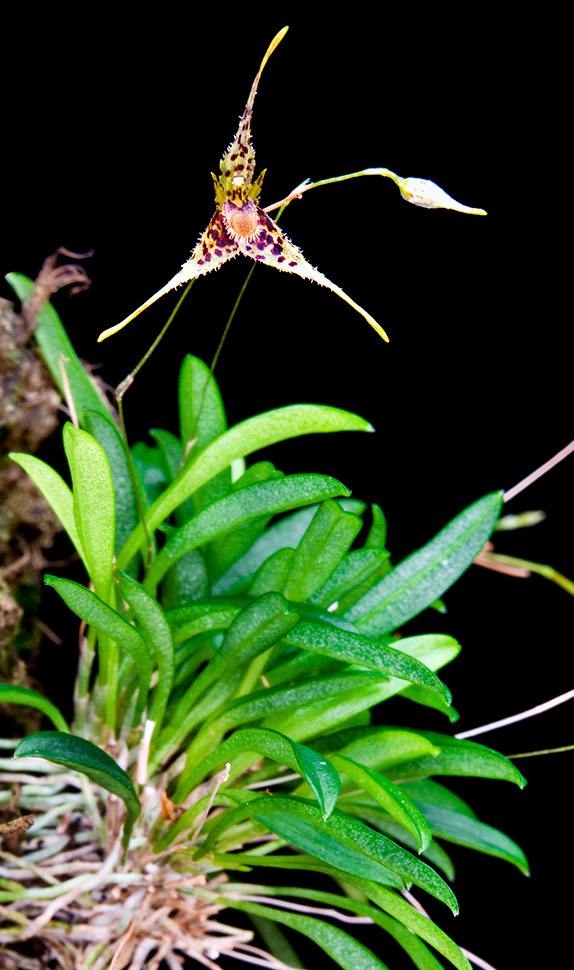Family : Orchidaceae

Text © Pietro Puccio

English translation by Mario Beltramini
The species is native to Belize, Guatemala, Honduras, Mexico (Campeche, Chiapas, Colima, Guerrero, Jalisco, Michoacán, Nayarit, Oaxaca, Quintana Roo, Tabasco, Veracruz and Yucatán), Nicaragua and Panama where it lives on the trees of the forests between 200 and 1600 m of altitude.
The name of the genus comes from Muscaria, analogous genus, in turn derived from the Latin substantive “musca, ae” = fly, with allusion to the shape of the flower; the specific name is the Latin perfect participle “marginatus, a, um” = marginate, hemmed, with reference to the margins of the leaves.

The Muscarella marginata is an epiphyte cespitose species amply diffused in tropical America © Giuseppe Mazza
The Muscarella marginata (Rich.) Luer (2006) is an epiphyte cespitose species with creeping rhizome and thin about 4 mm long unifoliate stems.
Erect oblanceolate-oblong leaves with tridentate apex, 1,5-2,5 cm long, petiole included, and 2-3 mm broad, coriaceous.
Lateral erect inflorescences, on a 2,5-4 cm long filiform peduncle, racemose, compact, with several translucent flowers, of pale yellow colour with purplish purple spots, that open in succession on a 6-8 mm long pedicel and ovary.
Ovate-triangular sepal, 5-7 mm long and about 1,5 mm broad, with fleshy caudate apex, 2-3 mm long, and irregularly denticulate margins, similar lateral sepals, united at the base per a length of about 2 mm.
Ovate-triangular petals with acute apex and irregularly serrate margins, 2,5-3 mm long and about 0,5 mm broad, trilobate unguiculate labellum with triangular lateral lobes, about 1 mm long, and median lobe, thick, convex, minutely warty, with obtuse apex and fringed margin, about 2 mm long and 1,5 mm broad, and about 2,5 mm long column.
It reproduces by seed, in vitro, but usually by division with each section provided of at least 4-5 stems.
Miniature orchid forming dense tufts with blooming lasting for long, requires a semi-shady position, intermediate temperatures, high ambient humidity, 70-80 %, and air in continuous movement.
It may be mounted on trunks, pieces of bark or rafts of various type covered by sphagnum in order to maintain humid the roots, or cultivated in pot with a draining compost that can be formed by fragments of medium broken sliced bark, charcoal and sphagnum.
Watering must be frequent, even daily when in presence of high temperatures, just slightly more spaced in winter, but without letting ever the substratum to dry up completely, as not having a precise period of rest, utilizing rainwater, by reverse osmosis or de-mineralized.
The species is inscribed in the appendix II of the CITES (species whose trade is internationally ruled).
Synonyms: Epidendrum marginatum Rich. (1792); Pleurothallis alata A.Rich. & Galeotti (1845); Pleurothallis spectrilinguis Rchb.f. (1882); Pleurothallis marginata (Rich.) Cogn. (1896); Pleurothallis hastata Ames (1908); Pleurothallis scopula Schltr. (1910); Pleurothallis liebmanniana Kraenzl. (1920); Specklinia hastata (Ames) Pridgeon & M.W.Chase (2001); Specklinia alata (A.Rich. & Galeotti) Solano & Soto Arenas (2003); Specklinia spectrilinguis (Rchb.f.) Luer (2004).
